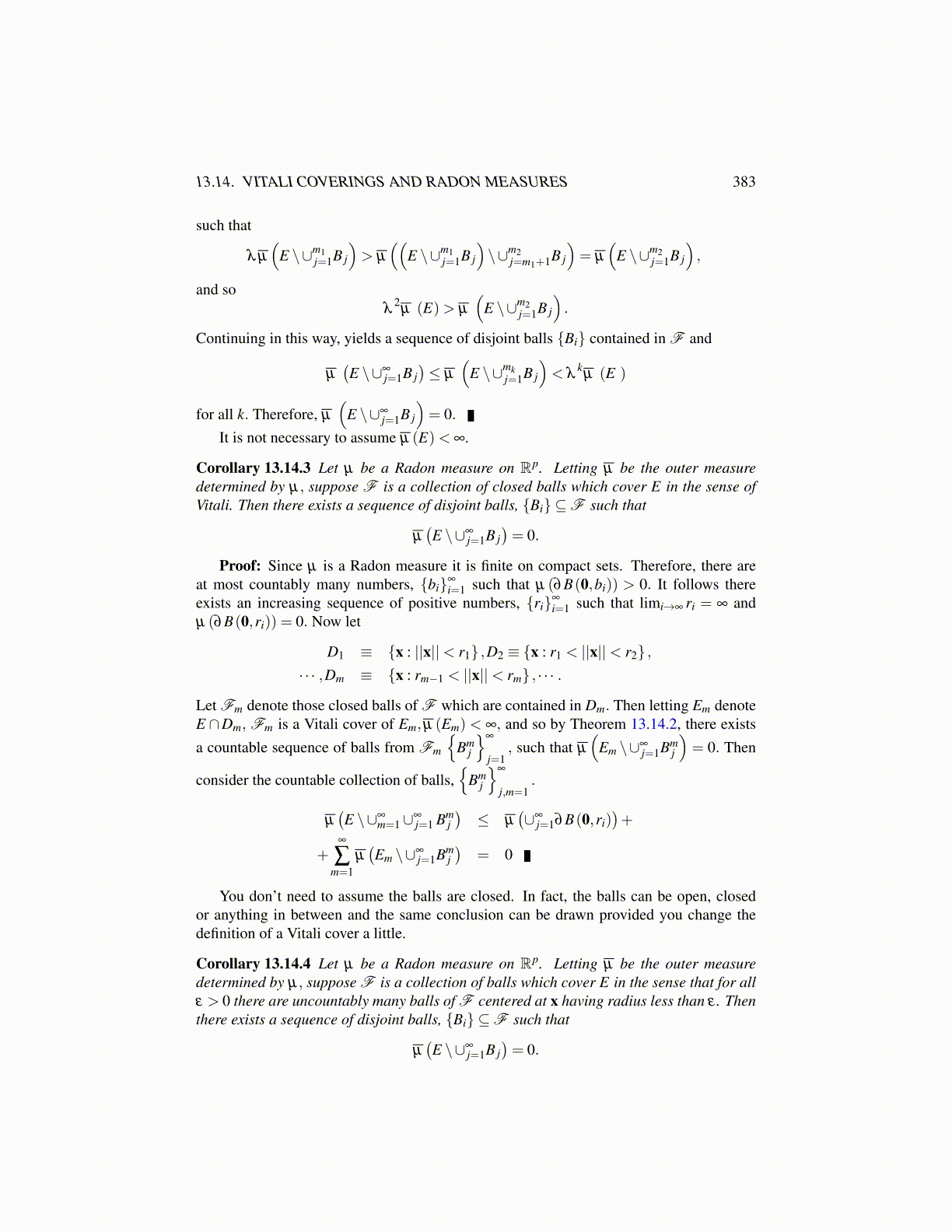
13.14. VITALI COVERINGS AND RADON MEASURES 383
such that
λ µ
(E \∪m1
j=1B j
)> µ
((E \∪m1
j=1B j
)\∪m2
j=m1+1B j
)= µ
(E \∪m2
j=1B j
),
and soλ
2µ (E)> µ
(E \∪m2
j=1B j
).
Continuing in this way, yields a sequence of disjoint balls {Bi} contained in F and
µ(E \∪∞
j=1B j)≤ µ
(E \∪mk
j=1B j
)< λ
kµ (E )
for all k. Therefore, µ
(E \∪∞
j=1B j
)= 0.
It is not necessary to assume µ (E)< ∞.
Corollary 13.14.3 Let µ be a Radon measure on Rp. Letting µ be the outer measuredetermined by µ, suppose F is a collection of closed balls which cover E in the sense ofVitali. Then there exists a sequence of disjoint balls, {Bi} ⊆F such that
µ(E \∪∞
j=1B j)= 0.
Proof: Since µ is a Radon measure it is finite on compact sets. Therefore, there areat most countably many numbers, {bi}∞
i=1 such that µ (∂B(0,bi)) > 0. It follows thereexists an increasing sequence of positive numbers, {ri}∞
i=1 such that limi→∞ ri = ∞ andµ (∂B(0,ri)) = 0. Now let
D1 ≡ {x : ||x||< r1} ,D2 ≡ {x : r1 < ||x||< r2} ,· · · ,Dm ≡ {x : rm−1 < ||x||< rm} , · · · .
Let Fm denote those closed balls of F which are contained in Dm. Then letting Em denoteE ∩Dm, Fm is a Vitali cover of Em,µ (Em) < ∞, and so by Theorem 13.14.2, there exists
a countable sequence of balls from Fm
{Bm
j
}∞
j=1, such that µ
(Em \∪∞
j=1Bmj
)= 0. Then
consider the countable collection of balls,{
Bmj
}∞
j,m=1.
µ(E \∪∞
m=1∪∞j=1 Bm
j)≤ µ
(∪∞
j=1∂B(0,ri))+
+∞
∑m=1
µ(Em \∪∞
j=1Bmj)
= 0
You don’t need to assume the balls are closed. In fact, the balls can be open, closedor anything in between and the same conclusion can be drawn provided you change thedefinition of a Vitali cover a little.
Corollary 13.14.4 Let µ be a Radon measure on Rp. Letting µ be the outer measuredetermined by µ, suppose F is a collection of balls which cover E in the sense that for allε > 0 there are uncountably many balls of F centered at x having radius less than ε . Thenthere exists a sequence of disjoint balls, {Bi} ⊆F such that
µ(E \∪∞
j=1B j)= 0.